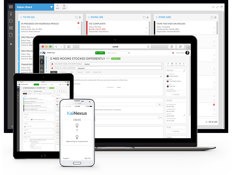 Incident reporting systems, widely used in healthcare and aviation, are becoming more popular with businesses of all types. It’s no wonder that organizations are interested in leveraging technology to support it. Incident reporting, along with corrective action and preventative action, is an essential part of continuous improvement. We’ve been asked quite a bit lately about what buyers should look for when evaluating incident reporting systems. Here are the critical features.
Incident reporting systems, widely used in healthcare and aviation, are becoming more popular with businesses of all types. It’s no wonder that organizations are interested in leveraging technology to support it. Incident reporting, along with corrective action and preventative action, is an essential part of continuous improvement. We’ve been asked quite a bit lately about what buyers should look for when evaluating incident reporting systems. Here are the critical features.
Available Anytime, from Anywhere on Any Device
It’s very convenient that so many business applications are available online these days. When it comes to incident reporting, the need for a cloud-based solution goes beyond convenience. It is essential that when an employee spots an incident that she can report it immediately, rather than take the risk that it will be forgotten or that key details will be lost. Look for a solution that will work on the mobile devices that employees are likely to have with them most of the time.
Integrated with Improvement Capabilities
The whole point of incident reporting is to take action to solve the problem (corrective action) and prevent it from happening again (preventative action). It only makes sense, therefore, that incidents be reported into a system designed to support the improvement effort that will follow. Consider software with notifications and alerts so that everyone involved in an improvement cycle stays engaged and informed.
Robust Reporting
The organization’s leadership needs visibility into the number, type, and frequency of incidents. Selecting incident reporting software with customizable dashboards is a good way to help executives track this very important measure of the health of the business. They should easily be able to see who is involved in improvement efforts and what areas of the business might need more attention.
Impact Measurement
The key to keeping executives and front-line employees alike engaged in improvement is to calculate and share the impact of those improvements. If you want people to understand how important incident reporting is to the organization, it is smart to broadcast the results of corrective and preventative actions in terms that people can understand, including the economic consequences of improvement work.
Accurate and Easy Search
Leaders who are responsible for analyzing incidents and taking action find the ability to search for past similar incidents and responses very helpful. The best solutions make it easy to find related events, review the lessons learned, and determine if a similar response is the right call or if something new is in order. You don’t want your team to have to reinvent the wheel, so it should be easy to reach back into your organization's repository of knowledge.
If you find a system that covers each of these bases, you will position yourself to have a solution that will be widely adopted by your staff and effective at capturing and resolving problems. There’s no need to settle for anything less.


Add a Comment